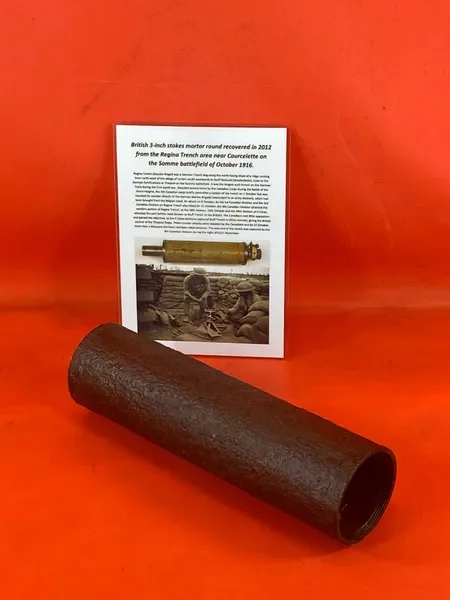 Image 1 of 8
Image 1 of 8

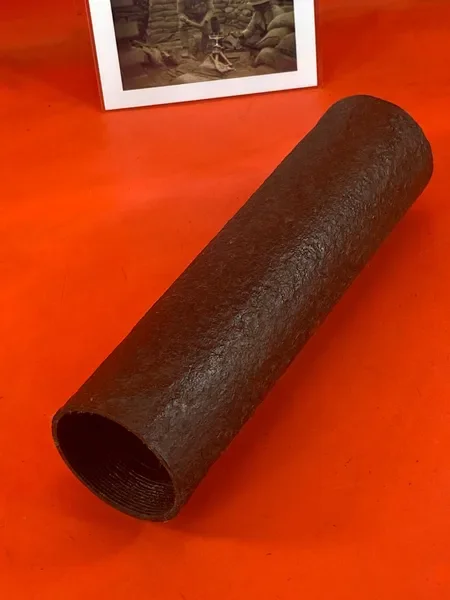 Image 2 of 8
Image 2 of 8

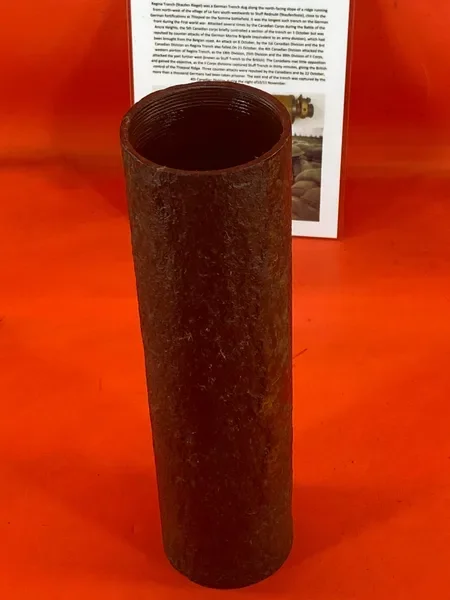 Image 3 of 8
Image 3 of 8

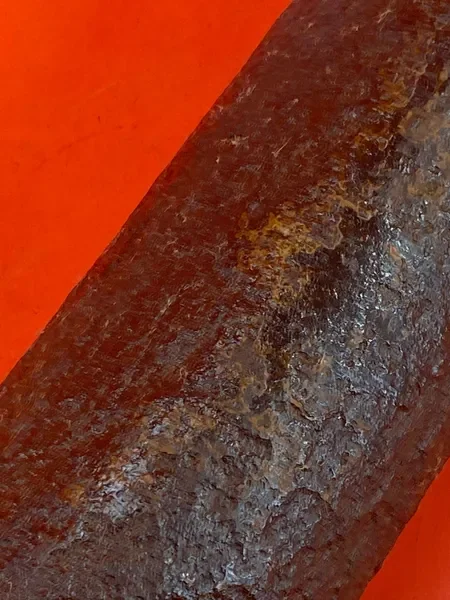 Image 4 of 8
Image 4 of 8

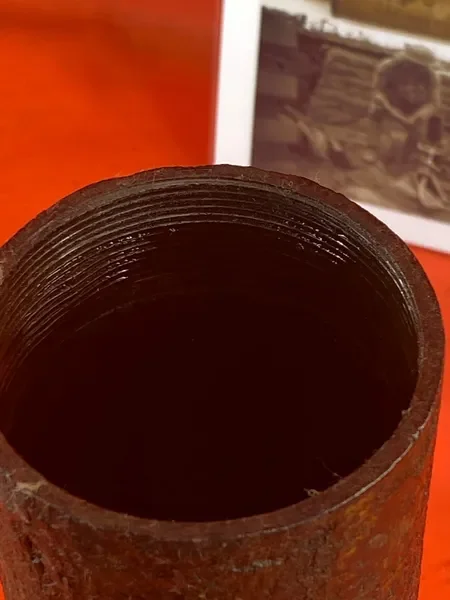 Image 5 of 8
Image 5 of 8

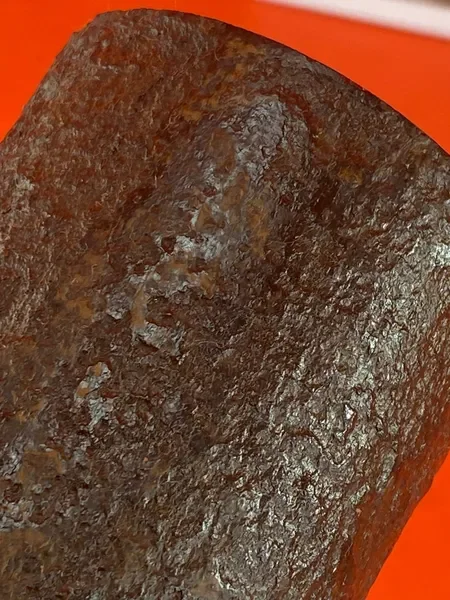 Image 6 of 8
Image 6 of 8

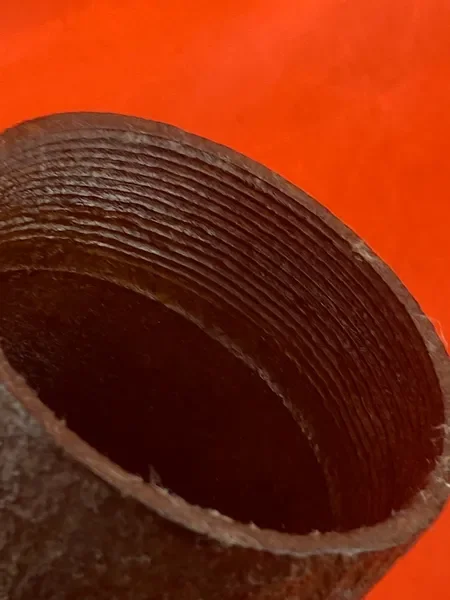 Image 7 of 8
Image 7 of 8

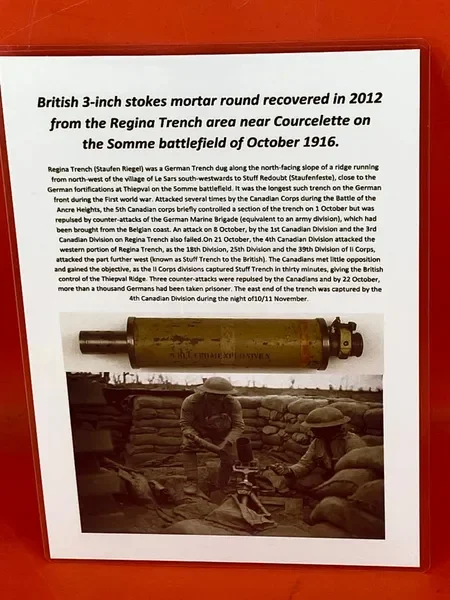 Image 8 of 8
Image 8 of 8









British 3 inch stokes mortar bomb empty tube recovered from the site of Regina Trench, a German defensive position near the village of Courcelette 1916
This is a British 3-inch Stokes mortar round (or bomb) in remarkably good condition for a battlefield relic. Both the top and bottom plates are missing, and the mortar is completely empty and inert, making it safe for display. The body is solid and stable, showing only light pitting, and retains traces of original interior colouring as well as some original black paint on the exterior.
The piece has been thoroughly and carefully cleaned, making it a rare example of a Stokes mortar bomb in such preserved condition especially one recovered directly from the battlefield. This would make a standout addition to any militaria collection or historical display.
This mortar bomb was recovered from the site of Regina Trench, a German defensive position near the village of Courcelette, on the Somme battlefield of October 1916. It was found 9 years ago, adding provenance to its historical value. The item comes with an A5 laminated information card detailing the background of both the artefact and the battle.
Historical Context Regina Trench (Staufen Riegel):
Regina Trench was a major German defensive line, dug along the north-facing slope of a ridge stretching from northwest of Le Sars to Stuff Redoubt (Staufenfeste), near Thiepval. It was the longest German trench on the Western Front during the First World War.
The trench was repeatedly attacked by the Canadian Corps during the Battle of the Ancre Heights in late 1916. Although briefly held by the 5th Canadian Corps on 1 October, they were repelled by fierce German counterattacks, notably from the elite German Marine Brigade. Further assaults on 8 October by the 1st and 3rd Canadian Divisions also failed.
However, on 21 October, the 4th Canadian Division, alongside British II Corps units (18th, 25th, and 39th Divisions), successfully captured significant sections of Regina and Stuff Trenches. The British gained full control of the Thiepval Ridge, repelling three German counterattacks and capturing over 1,000 German soldiers. The eastern end of the trench was finally taken by the 4th Canadian Division during the night of 10-11 November 1916
This is a British 3-inch Stokes mortar round (or bomb) in remarkably good condition for a battlefield relic. Both the top and bottom plates are missing, and the mortar is completely empty and inert, making it safe for display. The body is solid and stable, showing only light pitting, and retains traces of original interior colouring as well as some original black paint on the exterior.
The piece has been thoroughly and carefully cleaned, making it a rare example of a Stokes mortar bomb in such preserved condition especially one recovered directly from the battlefield. This would make a standout addition to any militaria collection or historical display.
This mortar bomb was recovered from the site of Regina Trench, a German defensive position near the village of Courcelette, on the Somme battlefield of October 1916. It was found 9 years ago, adding provenance to its historical value. The item comes with an A5 laminated information card detailing the background of both the artefact and the battle.
Historical Context Regina Trench (Staufen Riegel):
Regina Trench was a major German defensive line, dug along the north-facing slope of a ridge stretching from northwest of Le Sars to Stuff Redoubt (Staufenfeste), near Thiepval. It was the longest German trench on the Western Front during the First World War.
The trench was repeatedly attacked by the Canadian Corps during the Battle of the Ancre Heights in late 1916. Although briefly held by the 5th Canadian Corps on 1 October, they were repelled by fierce German counterattacks, notably from the elite German Marine Brigade. Further assaults on 8 October by the 1st and 3rd Canadian Divisions also failed.
However, on 21 October, the 4th Canadian Division, alongside British II Corps units (18th, 25th, and 39th Divisions), successfully captured significant sections of Regina and Stuff Trenches. The British gained full control of the Thiepval Ridge, repelling three German counterattacks and capturing over 1,000 German soldiers. The eastern end of the trench was finally taken by the 4th Canadian Division during the night of 10-11 November 1916
